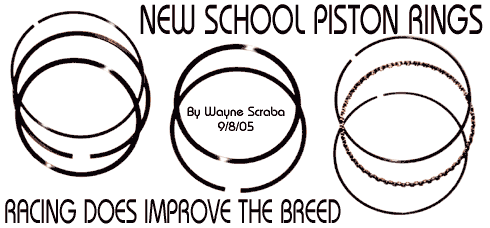| 
 t’s been said that some of the best sealing engines in all of motorsports are found under the hood of NHRA-legal Stockers. And that could very well be true. Just take one look at the restrictions facing a Stock Eliminator racer: Replacement pistons with OEM ring grooves. Limited creativity with regard to valve configurations (and valve jobs). No add-ons such as crankcase vacuum pumps. The methods used to seal these creations are pretty finite, and one of the keys is the piston ring. Sound interesting? Read on: t’s been said that some of the best sealing engines in all of motorsports are found under the hood of NHRA-legal Stockers. And that could very well be true. Just take one look at the restrictions facing a Stock Eliminator racer: Replacement pistons with OEM ring grooves. Limited creativity with regard to valve configurations (and valve jobs). No add-ons such as crankcase vacuum pumps. The methods used to seal these creations are pretty finite, and one of the keys is the piston ring. Sound interesting? Read on:

Ring Land: The part of the piston between the ring grooves and above the top ring that confines and supports the piston rings.
Heat Dam: A narrow groove in the top land used in some pistons to help control heat getting to the top ring. It actually fills with carbon in normal operation and limits heat flow to the ring.
Ring Belt: The area on the piston between the top of the pin bore and the top of the piston where the ring grooves are machined.
Groove Depth: The distance between the back of the ring groove and the cylinder wall with the piston centered.
Groove Root Diameter: Piston diameter measured at the back of the groove. May vary on the same piston between ring grooves.
Land Diameter: Diameter of a given land. Can sometimes vary by design from top to bottom.
Land clearance: The difference in diameter between the cylinder bore and the land diameter. "R" is 1/2 the total.
Groove Spacer: Used on re-grooved pistons to return a ring groove to specs or in some performance applications to facilitate the use of narrower ring sets than the grooves were originally cut for.
Free gap: The ring end clearance when the ring is uncompressed.
Compressed gap: Also known as ring gap, it is the end gap measured when the ring is installed.
Radial Wall Thickness: the distance between the inside and outside faces of the ring wall.
Ring Diameter: Measured with the ring installed.
Inside Diameter: Measured with the ring installed.
Ring Sides: The top and bottom surfaces of the ring.
Ring Face: The part of the ring in contact with the cylinder wall.
Side Clearance: Clearance between the ring groove and the ring.
Torsional Twist: A built-in imbalance between the way the upper and lower sides compress that causes a twist in the ring when compressed. Used to seal both the ring in the groove and the ring to the cylinder wall.
Back Clearance: Distance between the inside diameter of the ring and the bottom of the ring groove with the ring installed. |
Now, it’s no secret that you can seal an engine pretty well, but there are also plenty of trade-offs. And the worst one could very well be ring drag. That’s where Stock Eliminator becomes an enigma: Use a ring that seals the engine tight and in many instances, you’ll be met with considerable drag. The result is wasted horsepower. Of course, there are plenty of clever racers out there who have figured out how to have their cake and eat it too: The cost though, is quite often a bunch of added maintenance: Honing cylinder walls and re-ringing the engine in short-term intervals.
There’s more here too: Given the rules, a Stocker is pretty much forced to race with a big, fat ring. At least that’s what the piston rule more or less dictates. Typically, most Stockers use a piston with some form of 5/64-inch top and second ring groove along with a 3/16-inch (or thereabouts) oil ring package. Big heavy rings such as this (we’re primarily discussing the top two rings) are fine for low RPM engines, but when the tachometer needle starts cranking hard to the right (and more often than not, far beyond the range the OEM manufacturer originally intended), then ring weight becomes an issue. That’s one big reason why applications ranging from Pro Stock to Formula 1 use skinny, light top rings.
A heavy ring can be terribly upset by flutter. What is flutter? Ring flutter is believed to be caused by pressure that leaks by the top ring and but does not get by the second ring. Theory has it this creates pressure between the top and second ring that pushes down on the second ring and up on the top ring. This pressure, during proper circumstances, is said to be able to lift the top ring off its ring land creating ring flutter. There are a couple of theories out there on how to fix this dilemma: One is to open the gap on the second ring, and allow the pressure to escape. This might work, but it should also raise some red flags: If you open the gap, then you’re inviting blow-by, effectively kissing away the sealing capability of the ring.
It should be no surprise to any of you that filling the oil pan with combustion gases isn’t a great idea. And if you have no means to evacuate the crankcase, other than something like a PCV valve and a breather, it gets even worse. Blow-by not only robs the engine of power, it shortens the lubrication life of the crankcase oil and it causes internal engine parts to wear out prematurely. But in a Stocker, the biggest problem just might be might be the fact that power is continuously eroded as the ring gap increases in size.

|
